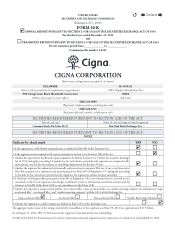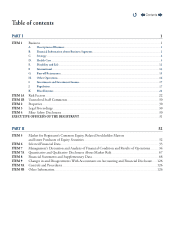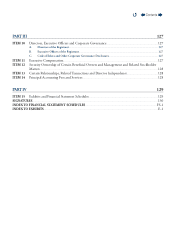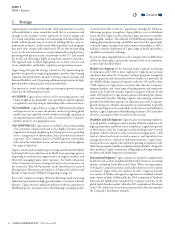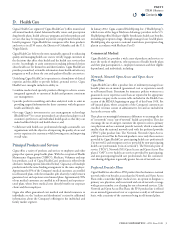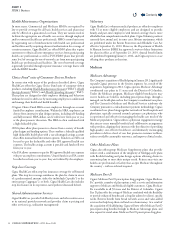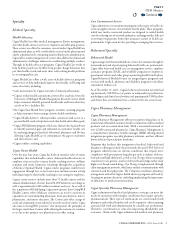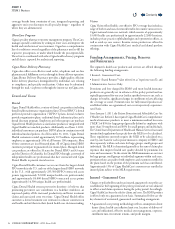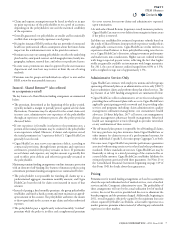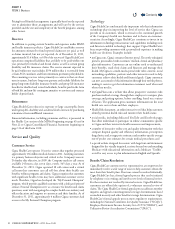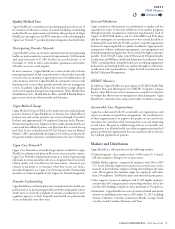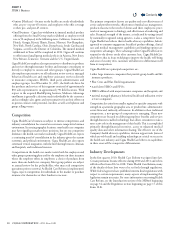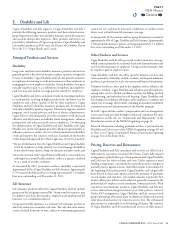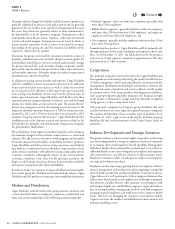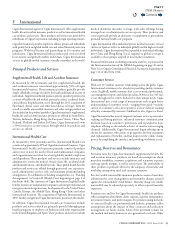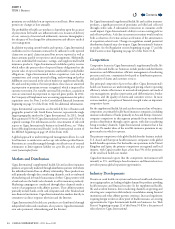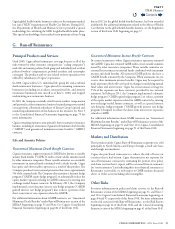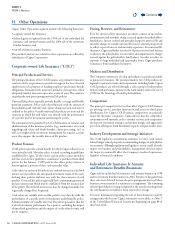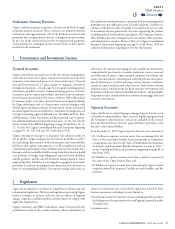Cigna 2011 Annual Report Download - page 29
Download and view the complete annual report
Please find page 29 of the 2011 Cigna annual report below. You can navigate through the pages in the report by either clicking on the pages listed below, or by using the keyword search tool below to find specific information within the annual report.
7CIGNA CORPORATION2011 Form10K
PARTI
ITEM 1 Business
•
Claim and expense assumptions may be based in whole or in part
on prior experience of the policyholder or on a pool of accounts,
depending on the policyholder’s size and the statistical credibility
of the experience.
•
Generally, guaranteed cost policyholders are smaller and less statistically
credible than retrospectively experience-rated groups.
•
Pricing for insurance/HMO products that use networks of contracted
health care professionals reects assumptions about the future claims
impact on the reimbursement rates in the provider contracts.
•
Premium rates may vary among policyholders to reect the underlying
plan benets, anticipated contract and demographic mix, family size,
geography, industry, renewal date, and other cost-predictive factors.
•
In some states, premium rates must be approved by the state insurance
department and state laws may restrict or limit the use of rating
methods.
•
Premium rates for groups and individuals are subject to state and/or
HHS review for unreasonable increases.
Insured - Shared ReturnsSM (also referred
to as experience-rated)
e key features of a Shared Returns funding arrangement are summarized
below:
•
e premium, determined at the beginning of the policy period,
typically includes a margin to partially protect against adverse claim
uctuations. Premiums may be adjusted for the actual claim and,
in some cases, administrative cost experience of the policyholder
through an experience settlement process after the policy period as
discussed below.
•
If cost experience is favorable in relation to the premium rates, a
portion of the initial premiums may be credited to the policyholder
as an experience refund. However, if claims and expenses exceed
the initial premiums (an “experience decit”), Cigna HealthCare
generally bears the risk.
•
Cigna HealthCare may recover an experience decit, according to
contractual provisions, through future premiums and experience
settlements, provided the policy remains in force. If premiums
exceed claims and expenses, any surplus amount is generally rst
used to oset prior decits and otherwise generally returned to
the policyholder.
Minimum premium funding arrangements combine insurance protection
with an element of self-funding. Key features of insurance policies using
a minimum premium funding arrangement are summarized below:
•
e policyholder is responsible for funding all claims up to a
predetermined aggregate, maximum monthly amount, and Cigna
HealthCare bears the risk for claim costs incurred in excess of that
amount.
•
Instead of paying a xed monthly premium, the group policyholder
establishes and funds a bank account and must maintain an agreed-
upon amount in the account. e policyholder authorizes the insurer
to draw upon funds in the account to pay claims and other authorized
expenses.
•
e policyholder pays a signicantly reduced monthly “residual”
premium while the policy is in eect and a supplemental premium
(to cover reserves for run-out claims and administrative expenses)
upon termination.
•
As with other Shared Returns (experience-rated) insurance products,
Cigna HealthCare may recover decits from margins in future years
if the policy is renewed.
Liabilities are established for estimated experience refunds based on
the results of Shared Returns (retrospectively experience-rated) policies
and applicable contract terms. Cigna HealthCare credits interest on
experience refund balances to these policyholders using rates that are
set at Cigna HealthCare’s discretion, taking investment performance
and market rates into consideration. Higher rates are credited to funds
with longer expected payout terms, reecting the fact that higher
yields are generally available on investments with longer maturities.
For 2011, the rates of interest credited ranged from 0.8% to 3.5%,
with a weighted average rate of approximately 1.5%.
Administrative Services Only
Cigna HealthCare contracts with employers, unions and other groups
sponsoring self-insured plans on an administrative services only (“ASO”)
basis to administer claims and perform other plan related services. e
key features of an ASO funding arrangement are summarized below:
•
Cigna HealthCare collects administrative service fees in exchange for
providing these self-insured plans with access to Cigna HealthCare’s
applicable participating provider network and for providing other
services and programs including: claim administration; quality
management; utilization management; cost containment; health
advocacy; 24-hour help line; 24/7 call center; case management;
disease management; pharmacy benet management; behavioral
health care management services (through its provider networks);
or any combination of these services.
•
e self-insured plan sponsor is responsible for self-funding all claims,
but may purchase stop loss insurance from Cigna HealthCare or
other insurers for claims in excess of a predetermined amount, for
either individuals (“specic”), the entire group (“aggregate”), or both.
•
In some cases, Cigna HealthCare provides performance guarantees
associated with meeting certain service related and other performance
standards. If these standards are not met, Cigna HealthCare may be
nancially at risk up to a stated percentage of the contracted fee or
a stated dollar amount. Cigna HealthCare establishes liabilities for
estimated payouts associated with these guarantees. See Note23 to
the Consolidated Financial Statements beginning on page119 of
this Form10-K for details about these guarantees.
Pricing
Premium rates for insured funding arrangements are based on assumptions
about the expected utilization levels of medical services, costs of medical
services and the Company’s administrative costs. e protability of
these arrangements will vary by the actual utilization level of medical
services, the cost of the services provided and the costs to administer the
benet programs and the premium charged. Additionally, beginning in
2011, overall margin is eectively capped by the minimum loss ratio
rebates required by Health Care Reform, as favorable experience in a
market generates premium rebates instead of osetting any unfavorable
experience in other markets.
Contents
Q


